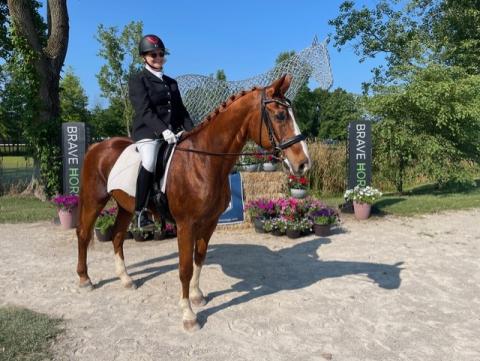Sherrie Ridenour and Her Horse Became Part of the Century Club
Just one look at Sherrie Ridenour, DVM, and her horse Antarez, better known as “Z”, and anyone can see they are a winning pair.
In summer 2024, the two were awarded official members of the Dressage Foundation’s prestigious Century Club, a program of the national organization that celebrates the enduring wisdom, experience and partnership between the senior rider and horse whose combined ages equal 100 years.

Ridenour, a small animal medicine veterinarian, is 71 and Z, a chestnut-colored Hanoverian, is 30. The two have been together since 2001.
Dressage, which means “training” in French, is a demanding equestrian sport, requiring horses to execute precise movements in response to barely perceptible signals from its rider. A successful dressage includes high scores on both technical and artistic movements.
“I was 70 when we competed for the Century Club,” Ridenour says. “That age always sounded old to me, but I don’t feel that. Thirty is pretty old for a horse and sometimes they’d rather go where they want to go at that age.”
The Mid-Ohio Dressage Classic event Ridenour and Z attended is held each year in Central Ohio. Ridenour says Z was really “awesome” at the show. “He presented himself well and was in great shape while feeling comfortable that day — I think horses live longer and healthier lives with such great veterinary care.”
Ridenour credits The Ohio State University Veterinary Medical Center’s (VMC) Equine Field Service team for providing Z with quality care since she got him in 2001. The team has seen Z at least twice a year since then, tending to his preventive care as well as past issues Z has had with joint, spine and neck issues.
It was going to be a little bit more demanding on him to do the movements during the Century Club competition, Ridenour says. “I normally don’t trot or canter him, but that is involved in the test, so we needed to know about the condition of his joints,” she says.
“That’s where the Ohio State team’s knowledge really helped us prepare. Their experience and state-of-the-art equipment allow them to more readily diagnose problems right on the farm here in Mt. Vernon.”
Ridenour recalls that when Z was much younger, he was lame. “We tried what we could on the farm, but it took going into the Ohio State Veterinary Equine hospital and having a bone scan to identify where the problem was,” she says.
“Now the team has equipment that can provide that kind of care right here on the farm,” she says.
“It’s good teamwork that keeps the horse going, and we can do a wide range of services on the farm,” says Jonathan A. Yardley, DVM, associate clinical professor, and team lead for the Ohio State VMC Equine Community Practice.
In addition to Z’s preventative health care and neurological exams, Yardley, and fellow VMC Equine Field service team member Katie Timko, DVM, assistant professor, perform more advanced procedures on him, including neck injections to keep him comfortable, and joint injections using biological products instead of steroids.
“It’s a team effort with Sherrie, as well as with her farrier who we recommended, and acupuncturist Michelle Bucci, who completed her internship with us,” says Yardley, who has cared for Z for 10 years.
In addition to joint care, Timko has performed gastroscopies on Z to manage ulcers. “Most horses Z’s age would not be able to do what he’s doing, so the joint effort that we’re doing alongside Sherrie is what’s been able to keep him going,” says Timko, who has been a part of Z’s care team since she was a resident, and then three years for field service.
“In field service, we can learn a tremendous amount about the environment in which the horse lives,” Yardley explains. “We gather valuable information about various factors, such as the type of footing they’re riding on, the condition of the pastures, the airflow in the barn, and much more.
“I always tell my fourth-year veterinary students that the physical examination of the horse begins as soon as we arrive at the farm, while the lameness assessment starts the moment we first see the horse. When the horse is in its home environment, it tends to let its guard down, which is vital for us as veterinarians to observe.”
For Yardley and Timko, providing care for a horse like Z on the farm is rewarding in many ways.
“I enjoy working with the owner to have their horse as an athlete perform to its highest potential,” Yardley says. He appreciates working horse and horse owners to keep their horse healthy even if it’s just a weekly trail ride. “The horse is not competing, but it’s giving the rider joy. It’s definitely the bond between the horse and rider that makes the relationship so special.”
For Timko, the reward is seeing clients out at shows doing what they’re wanting to do with their horse. “Every time they succeed, it’s also a success for us, because we are a part of helping them do their job,” she says.
As for herself, Ridenour keeps active doing Pilates and other core exercises to support her work in dressage with Z.
The Ohio State Field Service team gives her an added sense of ease just knowing that they will have the tools to address care options for Z to remain comfortable so that she can continue to keep riding him.
“I’m so grateful to have their expertise to evaluate his health,” she says.